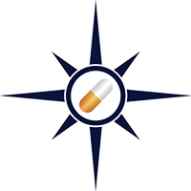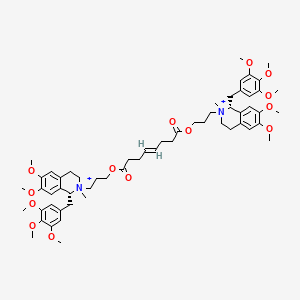



1. Bw B 1090u
2. Bw B1090u
3. Bw-b 1090u
4. Bw-b-1090u
5. Bw-b1090u
6. Bwb 1090u
7. Bwb1090u
8. Mivacron
9. Mivacurium Chloride
1. Mivacurium Cation
2. Mivacurium Chloride
3. Mivacron
4. Bw-b109ou
5. 133814-19-4
6. Bw B109ou
7. Bis[3-[(1r)-6,7-dimethoxy-2-methyl-1-[(3,4,5-trimethoxyphenyl)methyl]-3,4-dihydro-1h-isoquinolin-2-ium-2-yl]propyl] (e)-oct-4-enedioate
8. 106791-40-6
9. Chebi:6958
10. Bwb109ou
11. (1r)-2-(3-{[(4e)-8-{3-[(1r)-6,7-dimethoxy-2-methyl-1-[(3,4,5-trimethoxyphenyl)methyl]-1,2,3,4-tetrahydroisoquinolin-2-ium-2-yl]propoxy}-8-oxooct-4-enoyl]oxy}propyl)-6,7-dimethoxy-2-methyl-1-[(3,4,5-trimethoxyphenyl)methyl]-1,2,3,4-tetrahydroisoquinolin-2-ium
12. Ncgc00167469-01
13. Mivacurium Ion
14. Unii-77d66s9q93
15. Ncgc00183094-01
16. Dsstox_cid_28308
17. Dsstox_rid_82751
18. Dsstox_gsid_48333
19. Gtpl7243
20. Chembl1182833
21. Dtxsid6048333
22. Schembl10014476
23. Schembl10666872
24. Tox21_112909
25. 77d66s9q93
26. Db01226
27. Ncgc00167469-02
28. Cas-133814-19-4
29. C07550
30. 791m406
31. Q413877
32. Isoquinolinium, 2,2'-((1,8-dioxo-4-octene-1,8-diyl)bis(oxy-3,1-propanediyl))bis(1,2,3,4-tetrahydro-6,7-dimethoxy-2-methyl-1-((3,4,5-trimethoxyphenyl)methyl)-, (1r-(1r*(e(1'r*))))-
| Molecular Weight | 1029.3 g/mol |
|---|---|
| Molecular Formula | C58H80N2O14+2 |
| XLogP3 | 8.7 |
| Hydrogen Bond Donor Count | 0 |
| Hydrogen Bond Acceptor Count | 14 |
| Rotatable Bond Count | 30 |
| Exact Mass | 1028.56095523 g/mol |
| Monoisotopic Mass | 1028.56095523 g/mol |
| Topological Polar Surface Area | 145 Ų |
| Heavy Atom Count | 74 |
| Formal Charge | 2 |
| Complexity | 1550 |
| Isotope Atom Count | 0 |
| Defined Atom Stereocenter Count | 2 |
| Undefined Atom Stereocenter Count | 2 |
| Defined Bond Stereocenter Count | 1 |
| Undefined Bond Stereocenter Count | 0 |
| Covalently Bonded Unit Count | 1 |
For inpatients and outpatients, as an adjunct to general anesthesia, to facilitate tracheal intubation and to provide skeletal muscle relaxation during surgery or mechanical ventilation.
FDA Label
Mivacurium is a short-acting, nondepolarizing skeletal neuromuscular blocking agent which is hydrolyzed by plasma cholinesterase. Mivacurium results in a blockade of neuromuscular transmission by binding competitively with cholinergic receptors on the motor end-plate to antagonize the action of acetylcholine. The neuromuscular block produced by mivacurium is readily antagonized by anticholinesterase agents. The deeper the level of neuromuscular block at reversal, the longer the time required for recovery of neuromuscular function and the greater the dose of anticholinesterase agent required. Because spontaneous recovery after mivacurium is rapid, routine reversal may not always result in a clinical benefit.
Neuromuscular Nondepolarizing Agents
Drugs that interrupt transmission at the skeletal neuromuscular junction without causing depolarization of the motor end plate. They prevent acetylcholine from triggering muscle contraction and are used as muscle relaxants during electroshock treatments, in convulsive states, and as anesthesia adjuvants. (See all compounds classified as Neuromuscular Nondepolarizing Agents.)
M - Musculo-skeletal system
M03 - Muscle relaxants
M03A - Muscle relaxants, peripherally acting agents
M03AC - Other quaternary ammonium compounds
M03AC10 - Mivacurium chloride
Extensive and rapid via enzymatic hydrolysis catalyzed by plasma cholinesterase. Biotransformation may be significantly slowed in patients with abnormal or decreased plasma cholinesterase activity, especially individuals with a homozygous atypical cholinesterase gene abnormality.
The mean elimination half-life ranges from 1.7 to 2.6 minutes in healthy, young adults administered 0.1 to 0.25 mg/kg mivacurium. In 9 patients with end-stage liver disease undergoing liver transplant surgery, plasma clearance was approximately 50% lower than that in 8 control patients with normal hepatic function, while the elimination half-life increased to 4.4 minutes from the 1.8 minute control value.
Mivacurium binds competitively to cholinergic receptors on the motor end-plate to antagonize the action of acetylcholine, resulting in a block of neuromuscular transmission. This action is antagonized by acetylcholinesterase inhibitors, such as neostigmine.
